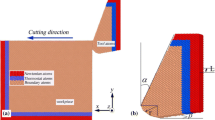Abstract
In this paper, large scale molecular dynamics simulations are carried out to investigate the thermal effect on nanometric cutting of copper while using a single tip and a multi-tip nanoscale diamond tool. A new concept of atomistic equivalent temperature is proposed and used to characterize the temperature distribution in the cutting zone. The results show that the cutting heat generated while using a multi-tip tool is larger than that of using a single tip tool. The local temperature is found to be higher at the inner sides of the multi-tip tool cutting edges than the outer sides. Applying centro-symmetry parameters and radius distribution function, the local annealing process and its effect on the integrity of the machined nanostructures are analyzed. It is observed that the local annealing at the machined surface can improve the surface integrity of the machined nanostructures, especially in the multi-tip diamond tool cutting process. There exists a great potential to control the thickness of residual atomic defect layer through an optimal selection of the cutting speed with designed depth of cut.
Similar content being viewed by others
References
Kong LB, Cheung CF, Jiang XQ, Lee WB, To S, Blunt L, Scott P (2010) Characterization of surface generation of optical microstructures using a pattern and feature parametric analysis method. Precis Eng 34:755–766
Sun J, Luo X, Chang W, Ritchie JM, Chien J, Lee A (2012) Fabrication of periodic nanostructures by single-point diamond turning with focused ion beam built tool tips. J Micromech Microeng 22:115014
Ye YY, Biswas R, Morris JR, Bastawros A, Chandra A (2003) Molecular dynamics simulation of nanoscale machining of copper. Nanotechnology 14:390–396
Adamsa DP, Vasile MJ, Krishnan ASM (2000) Microgrooving and microthreading tools for fabricating curvilinear features. Precis Eng 24:347–356
Picard YN, Adams DP, Vasile MJ, Ritchey MB (2003) Focused ion beam-shaped microtools for ultra-precision machining of cylindrical components. Precis Eng 27(1):59–69
Ding X, Lim GC, Cheng CK, Butler DL, Shaw KC, Liu K, Fong WS (2008) Fabrication of a micro-size diamond tool using a focused ion beam. J Micromech Microeng 18:075017
Xu ZW, Fang FZ, Zhang SJ, Zhang XD, Hu XT, Fu YQ, Li L (2010) Fabrication of micro DOE using micro tools shaped with focused ion beam. Opt Express 18(8):8025–8032
Pei QX, Lu C, Lee HP (2007) Large scale molecular dynamics study of nanometric machining of copper. Comput Mater Sci 41(2):177–185
Pei QX, Lu C, Lee HP, Zhang YW (2009) Study of materials deformation in nanometric cutting by large-scale molecular dynamics simulations. Nanoscale Res Lett 4:444–451
Fang TH, Weng CI (2000) Three-dimensional molecular dynamics analysis of processing using a pin tool on the atomic scale. Nanotechnology 11:148–153
Cho MH, Kim SJ, Lim DS, Jang H (2005) Atomic scale stick–slip caused by dislocation nucleation and propagation during scratching of a Cu substrate with a nanoindenter: a molecular dynamics simulation. Wear 259(7–12):1392–1399
Yan Y, Sun T, Dong S, Liang Y (2007) Study on effects of the feed on AFM-based nano-scratching process using MD simulation. Comput Mater Sci 40(1):1–5
Lin ZC, Huang JC (2008) A study of the estimation method of the cutting force for a conical tool under nanoscale depth of cut by molecular dynamics. Nanotechnology 19:115701
Foiles SM, Baskes MI, Daw MS (1986) Embedded-atom-method functions fo the fcc metals Cu, Ag, Au, Ni, Pd, Pt, and their alloys. Phys Rev B 33(12):7983–7991
Zhu PZ, Hu YZ, Ma TB, Wang H (2010) Study of AFM-based nanometric cutting process using molecular dynamics. Appl Surf Sci 256(23):7160–7165
Tersoff J (1988) New empirical approach for the structure and energy of covalent systems. Phys Rev B Condens Matter 37(12):6991–7000
Plimpton S (1995) Fast parallel algorithms for short range molecular dynamics. J Comput Phys 117:1–19
Norouzifard V, Hamedi M (2014) Experimental determination of the tool–chip thermal contact conductance in machining process. Int J Mach Tools Manuf 84:45–57
Nordlund K, Averback RS (1997) Point defect movement and annealing in collision cascades. Phys Rev B 56:2421–2431
Kalish R, Reznik A, Prawer S, Saada D, Adler J (1999) Ion-implantation-induced defects in diamond and their annealing: experiment and simulation. Phys Status Solidi 174:83–99
<http://isaacs.sourceforge.net/phys/rdfs.html>, g(r) RDF explanation accessed on 21 Nov 2011
Tong Z, Liang YC, Jiang XQ, Luo XC (2014) An atomistic investigation on the mechanism of machining nanostructures when using single tip and multi-tip diamond tools. Appl Surf Sci 290:458–465
Lu L, Sui ML, Lu K (2000) Superplastic extensibility of nanocrystalline copper at room temperature. Science 287:1463–1466
Saglam H, Yaldiz S, Unsacar F (2007) The effect of tool geometry and cutting speed on main cutting force and tool tip temperature. Mater Des 28:101–111
Kim SJ, Le D, Lee SW, Song KH, Lee DY (2014) Experiment-based statistical prediction on diamond tool wear in micro grooving Ni-P alloys. Diam Relat Mater 41:6–13
Cheng K, Luo X, Ward R, Holt R (2003) Modeling and simulation of the tool wear in nanometric cutting. Wear 255:1427–1432
Author information
Authors and Affiliations
Corresponding author
Rights and permissions
About this article
Cite this article
Tong, Z., Liang, Y., Yang, X. et al. Investigation on the thermal effects during nanometric cutting process while using nanoscale diamond tools. Int J Adv Manuf Technol 74, 1709–1718 (2014). https://doi.org/10.1007/s00170-014-6087-x
Received:
Accepted:
Published:
Issue Date:
DOI: https://doi.org/10.1007/s00170-014-6087-x




